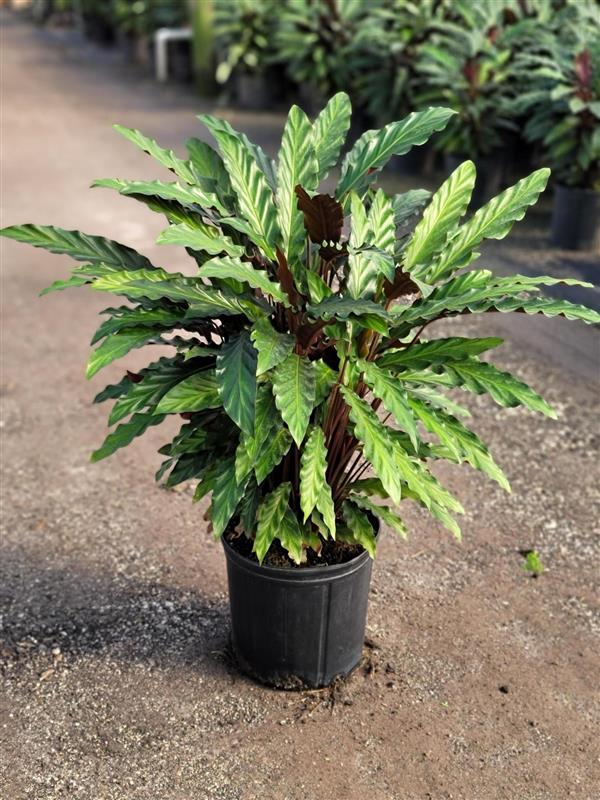Calathea Rufibarba
If you’re on the hunt for a plant that’s as beautiful as it is unique, the Calathea Rufibarba is a stunning choice. Known for its velvety, textured leaves and eye-catching patterns, this Calathea variety brings a lush, tropical flair to any space. Often referred to as the “Velvet Calathea” or the “Fuzzy Plant,” it will undoubtedly become a centerpiece in your indoor garden. In this guide, we’ll dive deep into what makes the Calathea Rufibarba so special and provide expert care tips to ensure it flourishes in your home.
What Makes the Calathea Rufibarba Special?
The Calathea Rufibarba is truly a marvel in the plant world, with its standout feature being its soft, velvety leaves, earning it the nickname “Fuzzy Plant.” The rich, deep green leaves feel incredibly soft to the touch, almost like velvet, while the undersides of the leaves contrast beautifully with a deep purple hue, adding a striking element of color. In addition to its texture, the leaves are long and oval-shaped, adorned with delicate, light green veins that create an intricate, lacy design, bringing an element of elegance. As a member of the Calathea family, the Rufibarba has the fascinating ability to move its leaves throughout the day, folding up at night and opening again with the sunrise, a behavior that adds a dynamic, living quality to your indoor garden. This unique movement gives the plant a sense of life and energy, making it even more captivating.

History of Calathea Rufibarba
Calatheas have been highly valued in the tropical regions of South America not only for their beauty but also for their symbolic significance. They are often associated with good luck and prosperity. The Rufibarba variety, with its luxurious, soft foliage, was introduced to the international plant market in the 20th century and has since become a favorite among houseplant collectors worldwide.
How to Care for Your Calathea Rufibarba
While the Calathea Rufibarba is a relatively easy plant to care for, it does require attention to a few specific conditions to thrive. Here’s everything you need to know about keeping your plant healthy and beautiful:
1. Light Requirements
The Calathea Rufibarba thrives in bright, indirect light. While it can tolerate some low-light conditions, it will show its best colors and patterns when placed in a spot with ample indirect sunlight. Avoid placing it in direct sunlight, as this can scorch the velvety leaves, causing discoloration and damage.
If the plant isn’t getting enough light, you may notice that the leaves become smaller or the vibrant patterns start to fade. A north- or east-facing window with filtered light is the ideal location for this plant. If your space lacks natural light, you can also supplement with a grow light to provide the necessary light for healthy growth.
2. Watering
The Calathea Rufibarba prefers consistently moist, but not soggy soil. Water when the top inch of soil feels dry, and ensure that excess water can drain freely through the pot. Avoid letting the plant sit in standing water, as this can cause root rot.
Use lukewarm water to prevent shocking the roots. Calatheas are also sensitive to fluoride and chlorine in tap water, which can lead to leaf damage. If possible, use distilled water, or let tap water sit out for 24 hours to allow the chemicals to dissipate before watering your plant.
3. Humidity
As a tropical plant, the Calathea Rufibarba thrives in high humidity. The ideal humidity range for this plant is between 60-80%. In homes with dry air, especially during the winter months, you may need to take steps to boost the humidity around your plant.
Here are a few ways to increase humidity:
- Misting: Lightly mist the leaves with water to raise the humidity level.
- Humidifier: Using a humidifier near the plant will help maintain the optimal humidity.
- Humidity Tray: Place the plant on a tray filled with pebbles and water, ensuring the bottom of the pot does not sit directly in the water.
- Grouping Plants: Placing the Calathea Rufibarba alongside other humidity-loving plants can help create a more humid microenvironment.
Be on the lookout for brown leaf tips or curling leaves, as these are common signs of low humidity.
4. Temperature
The Calathea Rufibarba prefers a warm environment with temperatures ranging between 65°F and 75°F (18°C to 24°C). Keep it away from areas with temperature fluctuations, such as near air conditioners, heaters, or drafts. Cold temperatures below 60°F (15°C) can cause stress and stunt growth, so avoid placing it in chilly spots like near open windows during colder months.
5. Soil
For best results, use a well-draining, peat-based potting mix for your Calathea Rufibarba. A mix designed for houseplants works well, but you can improve drainage by adding perlite, orchid bark, or coconut coir. The soil should retain some moisture but not become waterlogged, as too much moisture can cause root rot.
Make sure the pot you use has drainage holes to prevent water from accumulating in the bottom. Never let the plant sit in excess water in the saucer.
6. Fertilizing
During the growing season (spring and summer), feed your Calathea Rufibarba once a month with a balanced, water-soluble fertilizer diluted to half strength. This helps to promote healthy, vibrant growth and maintain the plant’s stunning foliage.
In the fall and winter, reduce fertilizing as the plant’s growth naturally slows down. Over-fertilizing can lead to salt buildup in the soil, which can cause leaf burn and other problems, so it’s better to under-fertilize than overdo it.
7. Pruning
To maintain the plant’s shape and keep it looking fresh, regularly remove any yellowing, dead, or damaged leaves. This not only keeps the plant tidy but also redirects the plant’s energy into producing new growth. You can also prune the Calathea Rufibarba to control its size, especially if it starts to get too large for the space.
8. Repotting
Repot the Calathea Rufibarba every 1 to 2 years or when it outgrows its pot. Choose a pot that is 1-2 inches larger than the current one to allow room for growth. It’s best to repot during the spring or early summer, as the plant will be actively growing at this time and better able to adjust to the new pot.
Why You Should Add a Calathea Rufibarba to Your Collection
The Calathea Rufibarba is a must-have for plant enthusiasts seeking a unique, visually striking addition to their collection. With its velvety leaves and bold, contrasting patterns, it adds a luxurious, tropical atmosphere to any room.
Not only is this plant a visual showstopper, but it also brings a sense of life to your space with its dynamic leaf movements. Whether you have a spacious living room, cozy bedroom, or even an office, the Calathea Rufibarba will thrive with the right care and add an air of elegance wherever it’s placed.
